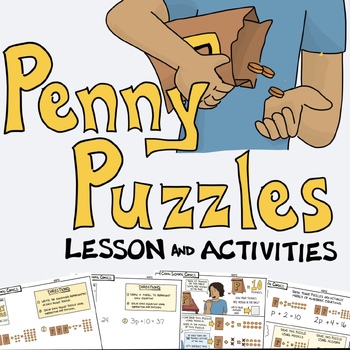Fun Summer School Math Activities One & Two Step Equations Worksheets & Project
- Zip
Description
Transform your 8th grade summer school math curriculum with these fun and engaging, print-and-go, comics and activities. Whether you are searching for fun summer school math activities or simply providing summer tutoring, this resource will improve retention. By the end of this 8th-grade math lesson and project, your students will fully understand how to solve one and two-step equations.
Comics have the power to present information visually and engage even the most reluctant reader.
The penny puzzles will help students grasp the concept of variables and why we use inverses to solve one and two-step equations. Multiple worksheets are provided to reinforce understanding and challenge learners to apply their skills.
I used these puzzles with my at-risk 8th-grade math class and my students TRULY UNDERSTOOD how to solve multi-step equations. Even my learners who believed they were horrible at math were able to grasp these puzzles. This approach to teaching one and two-step equations works better than any worksheets I tried in the past.
This comic-style lesson will help your learners understand algebraic reasoning and leave them with a deep understanding of why we solve equations the way we do.
By the end of this lesson, your students will never forget how to solve algebraic expressions!
Overview
Penny Puzzles are a great way to introduce the concepts of variables and solve two-step equations. This 5-Part Lesson builds on the concept of guiding learners toward solving multi-step equations.
Your students will have a solid foundational understanding and the confidence to conquer equations that were once intimidating.
Students use logic and algebraic reasoning to determine the number of pennies hidden in paper bags. Then, students use variables and expressions to model the puzzle. Through cancellation and equation balancing, students learn to solve two-step equations.
This activity gives students a real-world example of algebraic reasoning and allows them the opportunity to take an active role in the learning process.
What's Inside the Two-Step Equation Lesson?
Part 1- Solving Penny Puzzles
- Visual "How-to"
- Introduces Penny Puzzles in an illustrated manner
- Presents information in a medium that is approachable and engaging
- Even your most reluctant learners will get roped in!
- Comes with Doodle note-style guided notes!
- Both color and black-and-white
Part 2- Equation Time
- Turn models into equations
- Solve one and two-step equations using inverses
- Students will grasp why we use inverses to solve equations
- Comes with Doodle note-style guided notes!
- Both color and black-and-white
Part 3- Practice!
- Students will start solving penny puzzles on their own
- They will be expected to translate each puzzle into an equation using variables.
- They will also be expected to solve the equations using inverses
- Both color and black-and-white
Part 4- Reverse Practice
- Now, students will be challenged to change algebraic expressions into penny puzzles
- They will need to draw models to represent the two-step equations they are given
- They will also be expected to solve the two-step equations using inverses
- Both color and black-and-white
Part 5- Create Your Own
- Low-prep, hands-on activity
- Students break into teams and create their own penny puzzles using paper bags and pennies
- Each team will set up a penny puzzle for their classmates to try
- Instructions are presented in a written and visual format making them accessible to all
- Learners use logic and problem-solving skills to participate in this activity
- Both color and black-and-white
Part 6- Penny Puzzle Challenge
- Students are challenged to solve multi-step algebraic equations
- Each equation has the variable on both sides
- Will they be able to apply what they have learned about inverses and models to accomplish this challenge?
- Both color and black-and-white
*Answer keys are included at the end!
*Doodle Notes is a trademarked term used with permission. Please visit www.Doodlenotes.org for more information.
Related Products
Common Core Standards
CCSS.Math.Content.6.EE.B.6
Use variables to represent numbers and write expressions when solving a real-world or mathematical problem; understand that a variable can represent an unknown number, or, depending on the purpose at hand, any number in a specified set.
CCSS.Math.Content.7.EE.B.4
Use variables to represent quantities in a real-world or mathematical problem, and construct simple equations and inequalities to solve problems by reasoning about the quantities.





